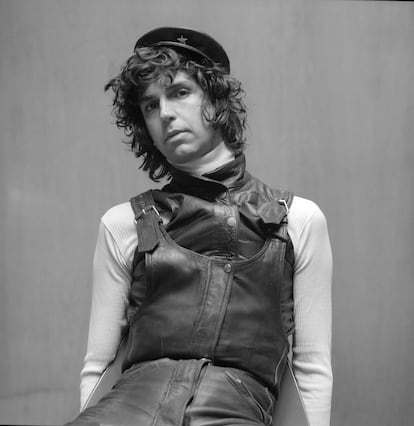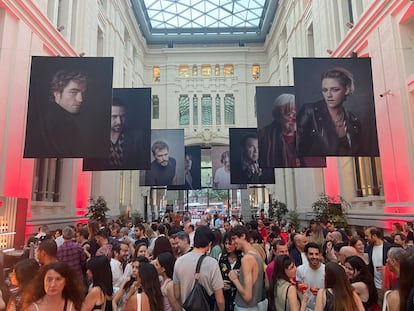Jorge Fuembuena (Zaragoza, 45 years old) is considered a photographer because he makes a living taking photographs, but because of the way he takes them, he believes he should be considered an artist. The native of Zaragoza, who moves between the world of cinema and photography, is involved in several film projects, including the film Hunting daydirected by Pedro Aguilera, with Carmen Machi, Rossy de Palma and Blanca Portillo as protagonists. In addition, this summer (until September 12) presents the exhibition Through the gaze in the glass gallery of CentroCentro in Madrid, as part of the summer film series ‘Cibeles de Cine’. Fuembuena is showing 24 portraits taken over the years at the San Sebastian festival.
At the exhibition, the face of film director Agnès Varda welcomes you with a sidelong glance and her two-tone hair. Behind her, portraits of 23 artists hang from the transparent dome, including actors and actresses such as Julie Delpy, Timothée Chalamet, Johnny Depp, Ana de Armas, Jessica Chastain and Susan Sarandon.
When both worlds, cinema and photography, come together, Fuembuena’s answer is always yes. His portraits are the result of an “intimate encounter of great horizontality, where the viewer finds his own reflection,” describes the photographer. Fuembuena emphasizes that a dialogue is generated “between author, reader and viewer” in which empathy is essential. “You have to put yourself in the place of others, it is like a ritual of meeting people, an opportunity to get closer to the other.”
It is difficult to create such an intimate atmosphere during such stressful days as those of a film festival, but it is precisely this hustle and bustle that this photographer likes, unlike studio sessions, where the subject is alone before the gaze of the one who contemplates and interprets him. In this solitude, it is easier for him to create the “emotional correspondence” necessary to obtain a good image. It is this conversation with the person on the other side of the camera that interests Fuembuena in portraiture, whose key element is the gaze. The direction of the eyes, sometimes elusive in his photographs, allows him to create “potential narratives.” For this reason, he says, the images are not good at explaining, but rather are partial visions.
Beyond being his job, photography serves as a means of knowledge and interaction with others. Through it, he develops critical, divergent and even political thinking. “In artistic practice there is always an ethical and anthropological dimension related to the possibility of human freedom. I use photography as an instrument to reflect on the nature of the individual and the social being,” he explains. Then, the concern arises to know the reflection that resides in the portraits he exhibits in Cibeles of cinemaHe describes it as a game of reality immersion, “the exploration of oneself through the other’s gaze.”

In Through the gazeFuembuena was inspired by the history of portraiture, by Greek and Roman busts, by El Greco, Dürer and Raphael, and by their individual portraits that eliminated the superfluous. In doing so, he aspired to create a pictorial space. He tried to make the subjects break the clichés of the smile, a countenance that, together with their position, gives them the desired sculptural image.
Fuembuena highlights the camera he uses in his method, a Wista plate camera, a 19th century model that works with a bellows that connects the lens to the plate that captures the image. He does not take more than three photographs of each person and, in his words, he does not shoot, that is paparazzi’s thing, his thing “is the photographic act”, so he takes his time to take the desired image.
Although he is mostly known for his work in cinema, Fuembuena also develops “personal creative projects”, which he has been working on for more than 10 years. The first, Boys from the creekwas the result of his scholarship at the Spanish Academy in Rome and dealt with the contradictions, mystery and conflict in the work of the Italian writer and filmmaker Pier Paolo Pasolini. Inspired by the figures of Caravaggio, he visited the Roman neighborhoods where the director filmed to capture the beauty of failure. He also has a work on Buñuel, An insect, which explores faith, eroticism and death, so present in the work of the Spanish filmmaker, and a final project that he started thanks to EL PAÍS, when the newspaper published that Berlanga’s erotic archive was being auctioned, which he has now digitized.

